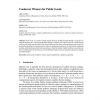Free Online Productivity Tools
i2Speak
i2Symbol
i2OCR
iTex2Img
iWeb2Print
iWeb2Shot
i2Type
iPdf2Split
iPdf2Merge
i2Bopomofo
i2Arabic
i2Style
i2Image
i2PDF
iLatex2Rtf
Sci2ools
ANOR
2005
2005
Condorcet Winners for Public Goods
In this work, we consider a public facility allocation problem decided through a voting process under the majority rule. A location of the public facility is a majority rule winner if there is no other location in the network where more than half of the voters would have been closer to than the majority rule winner. We develop fast algorithms for interesting cases with nice combinatorial structures. We show that the computing problem and the decision problem in the general case, where the number of public facilities is more than one and is considered part of the input size, are all NP-hard. Finally, we discuss majority rule decision making for related models.
| Added | 15 Dec 2010 |
| Updated | 15 Dec 2010 |
| Type | Journal |
| Year | 2005 |
| Where | ANOR |
| Authors | Lihua Chen, Xiaotie Deng, Qizhi Fang, Feng Tian |
Comments (0)

